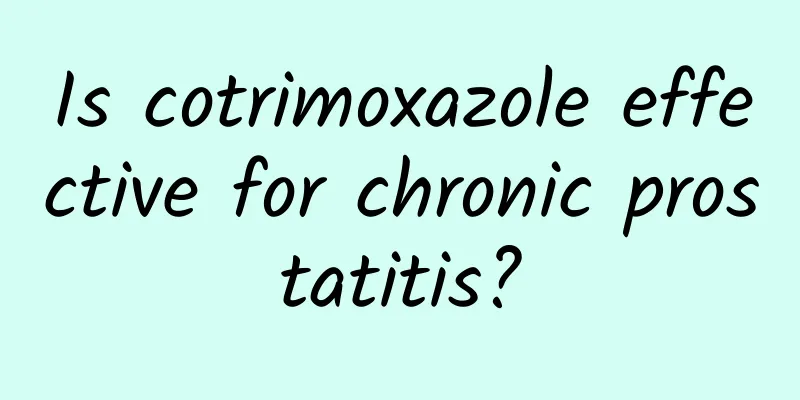Is cotrimoxazole effective for chronic prostatitis?

|
In real life, chronic prostatitis is a common physical disease for many men. Chronic prostatitis can easily affect the health of the body and easily lead to some complications, which have a great impact on the body. There are many kinds of drugs for the treatment of chronic prostatitis. You can choose co-trimoxazole, which has therapeutic effects.
There are two treatment goals for chronic bacterial prostatitis: one is the so-called "curative" treatment, and the other is "suppressive" treatment. Curative treatment is to eliminate the infection focus in the prostate and eliminate the cause of the persistent bacteriuria. Suppressive treatment is to inhibit the growth of bacteria in urine through antibacterial drugs, which can often completely eliminate the patient's clinical symptoms and greatly reduce the risk of serious diseases caused by prostate infection lesions. Using antibiotics to eliminate bacterial infection lesions requires that the appropriate antibiotics can reach sufficient concentrations at the infection site. Unlike acute prostatitis, chronic prostatitis has a stronger tolerance to antibiotic treatment, which requires the selection of drugs that can fully diffuse into the prostate gland, that is, they are fat-soluble and do not bind to serum proteins. However, many clinical studies have reported that almost no drugs can truly cure chronic bacterial prostatitis. Co-trimoxazole is currently the most widely used and most effective drug for the treatment of chronic bacterial prostatitis. This is because sulfamethoxazole has a high fat solubility and is an alkaline drug. Its concentration in the prostate is 2 to 3 times higher than that in plasma. Although the content of sulfamethoxazole in prostatic fluid is not as high as that in plasma, the half-lives of the two are similar, and combined use has a good synergistic effect on Gram-negative bacteria. Patients who take co-trimoxazole orally for 4 to 16 weeks can generally achieve a cure rate of 30% to 40%, which is a significant improvement over the cure rate of short-term treatment.
According to the principle of individualization, a comprehensive and effective detailed plan for the prevention of prostatitis is formulated for specific patients and supervised and implemented, which may achieve good results. Prostatitis patients can be completely cured after formal and systematic treatment. Although the pathogens in the prostate have been completely eliminated in the short term after the cure, it does not mean that the prostate tissue damage caused by the infection has been completely repaired. During the recovery period of the disease, the prostate may often be in a sub-healthy state, and it is easier to be infected with pathogens again or cause obvious congestion of the prostate again than the general population, causing the symptoms of prostatitis to reappear. Preventing reinfection with pathogens is an issue that doctors and cured patients need to pay special attention to. Some doctors recommend the long-term use of sensitive antibiotics in small doses for preventive treatment. In addition, the appropriate use of α receptor blockers can also significantly improve the blood circulation of the prostate and the tension of the tissues around the prostate, eliminate the reflux of urine in the prostate during urination, and thus reduce the recurrence and reinfection of prostatitis. Functional damage to the pelvic floor muscles may be one of the culprits of prostatitis. Biofeedback technology can guide patients to recognize and correct the contraction of the pelvic floor muscles during urination, perform contraction/relaxation exercises, restore muscle activity to the normal dynamic range, encourage continuous muscle function exercise in the family, voluntarily relax the pelvic floor muscles, and gradually increase the urination interval time. Effective measures that can be taken include improving diet and bad living habits, keeping the perineum clean and dry, avoiding excessive fatigue, having regular sex or regularly expelling semen when excited, strengthening nutrition, improving the body's health, proper physical exercise, and enhancing the body's resistance. These measures can not only help patients effectively relieve physiological and psychological symptoms, but also help prevent reinfection with bacteria and other pathogenic microorganisms. |
<<: Can Houttuynia cordata treat prostatitis?
>>: How effective is targeted treatment for prostatitis?
Recommend
Elbow pain, what factors are causing it?
The elbow is supposed to be a very hard part, oth...
It's normal to ejaculate after just a few minutes of sex
Sex life is also called love. A harmonious sex li...
There are many things to pay attention to when eating for tuberculous orchitis
Tuberculous orchitis is a common male disease. Ma...
What is the cause of the white pimples under the glans scalp?
White pimples appear under the glans, and you sho...
When is the best sperm quality?
I believe that for many young couples, having a h...
What is scrotal prolapse?
The testicle is one of the male organs that secre...
What are the semen tests? Learn about the five test items early
Semen examination includes many items. The genera...
A nourishing diet for men's sexual fatigue
Sexual fatigue refers to systemic wasting disease...
What are the disadvantages of men not ejaculating?
Every man wants to save face and wants to last lo...
If men keep running, this ability will actually improve!
What benefits does running bring to people? Howev...
What harm does chronic prostatitis cause in men?
Many people say that the prostate is a man's ...
Does testicular torsion affect fertility?
The most serious part of the body affected by tes...
What is the best way to treat prostate calcification?
There are many ways to treat prostate calcificati...
Urinating after circumcision
In life, many male friends have the phenomenon of...
How many minutes does it take for sperm to liquefy?
Most sperm will liquefy within a few minutes afte...









